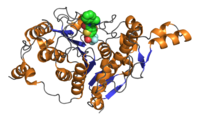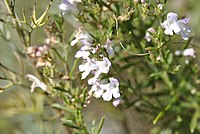
Reactive oxygen and nitrogen species as key indicators of plant responses to Cd stress
Sign Up to like & getrecommendations! Published in 2019 at "Environmental and Experimental Botany"
DOI: 10.1016/j.envexpbot.2018.10.012
Abstract: Abstract Although cadmium (Cd), an extremely toxic non-essential heavy metal, has no biological function, it is capable of entering plant roots. Cd not only presents a problem for plants, which have developed specific Cd detection,… read more here.
Keywords: plant responses; plant; reactive oxygen; nitrogen species ... See more keywords

Involvement of nitric oxide (NO) in plant responses to metalloids.
Sign Up to like & getrecommendations! Published in 2021 at "Journal of hazardous materials"
DOI: 10.1016/j.jhazmat.2021.126606
Abstract: Plants respond to the limited or excess supply of metalloids, boron (B), silicon (Si), selenium (Se), arsenic (As), and antimony (Sb) via complex signaling pathways that are mainly regulated by nitric oxide (NO). The absorption… read more here.
Keywords: involvement nitric; oxide plant; plant responses; nitric oxide ... See more keywords

Coordinated Transcriptional Regulation by the UV-B Photoreceptor and Multiple Transcription Factors for Plant UV-B Responses.
Sign Up to like & getrecommendations! Published in 2020 at "Molecular plant"
DOI: 10.1016/j.molp.2020.02.015
Abstract: Non-damaging ultraviolet-B (UV-B) light promotes photomorphogenic development and stress acclimation in Arabidopsis through UV-B-specific signal transduction. UV-B irradiation induces monomerization and nuclear translocation of the UV-B photoreceptor UV RESISTANCE LOCUS 8 (UVR8). However, it is… read more here.
Keywords: transcription; photoreceptor; plant responses; transcription factors ... See more keywords

Plant responses to heterogeneous salinity: agronomic relevance and research priorities.
Sign Up to like & getrecommendations! Published in 2022 at "Annals of botany"
DOI: 10.1093/aob/mcac022
Abstract: BACKGROUND Soil salinity, in both natural and managed environments, is highly heterogeneous and understanding how plants respond to this spatiotemporal heterogeneity is increasingly important for sustainable agriculture in the era of global climate change. While… read more here.
Keywords: responses heterogeneous; heterogeneous salinity; plant responses; research ... See more keywords

Essential trace metals in plant responses to heat stress.
Sign Up to like & getrecommendations! Published in 2021 at "Journal of experimental botany"
DOI: 10.1093/jxb/erab507
Abstract: Essential trace metals function as structural components or cofactors in many proteins involved in a wide range of physiological processes in plants. Hence, trace metal deficiency can significantly hamper plant growth and development. On the… read more here.
Keywords: plant; heat stress; plant responses; trace metals ... See more keywords

Role of Jasmonate signaling in regulation of plant responses to nutrient deficiency stresses.
Sign Up to like & getrecommendations! Published in 2022 at "Journal of experimental botany"
DOI: 10.1093/jxb/erac387
Abstract: Phytohormones regulate plant growth and development by integrating various internal developmental cues with external environmental conditions. Jasmonic acid (JA) is oxylipin-derived phytohormone that modulates the plasticity of plant responses against fluctuating environmental cues. An increasing… read more here.
Keywords: nutrient deficiency; plant responses; role; development ... See more keywords

Phytohormones in plant responses to boron deficiency and toxicity.
Sign Up to like & getrecommendations! Published in 2022 at "Journal of experimental botany"
DOI: 10.1093/jxb/erac443
Abstract: Boron (B) is an essential element for plant growth. Many agricultural soils around the globe have either insufficient or excessive amounts of available B, with major implications for crop production. Understanding major limitations imposed by… read more here.
Keywords: plant responses; root; toxicity; phytohormones plant ... See more keywords

The function of S-nitrosothiols during abiotic stress in plants
Sign Up to like & getrecommendations! Published in 2019 at "Journal of Experimental Botany"
DOI: 10.1093/jxb/erz197
Abstract: Nitric oxide (NO) is an active redox molecule involved in the control of a wide range of functions integral to plant biology. For instance, NO is implicated in seed germination, floral development, senescence, stomatal closure,… read more here.
Keywords: plant responses; function nitrosothiols; abiotic stress; stress ... See more keywords

Plant Responses to a Daily Short-term Temperature Drop: Phenomenology and Mechanisms
Sign Up to like & getrecommendations! Published in 2020 at "Russian Journal of Plant Physiology"
DOI: 10.1134/s1021443720060187
Abstract: The review analyzes and generalizes literary data and the authors’ results demonstrating the principal difference in plant responses to low-temperature treatments of two different types: (1) long-term constant chilling and (2) short-term daily cooling (temperature… read more here.
Keywords: temperature drop; short term; plant; plant responses ... See more keywords

Plant Responses to Abiotic Stress Regulated by Histone Deacetylases
Sign Up to like & getrecommendations! Published in 2017 at "Frontiers in Plant Science"
DOI: 10.3389/fpls.2017.02147
Abstract: In eukaryotic cells, histone acetylation and deacetylation play an important role in the regulation of gene expression. Histone acetylation levels are modulated by histone acetyltransferases and histone deacetylases (HDACs). Recent studies indicate that HDACs play… read more here.
Keywords: plant; histone deacetylases; plant responses; abiotic stress ... See more keywords

Plant Responses Underlying Timely Specialized Metabolites Induction of Brassica Crops
Sign Up to like & getrecommendations! Published in 2022 at "Frontiers in Plant Science"
DOI: 10.3389/fpls.2021.807710
Abstract: A large subset of plant stress-signaling pathways, including those related with chemical defense production, exhibit diurnal or circadian oscillations. However the extent to which diurnal or circadian time influences the stress mediated accumulation of plant… read more here.
Keywords: time; specialized metabolites; plant responses; plant ... See more keywords